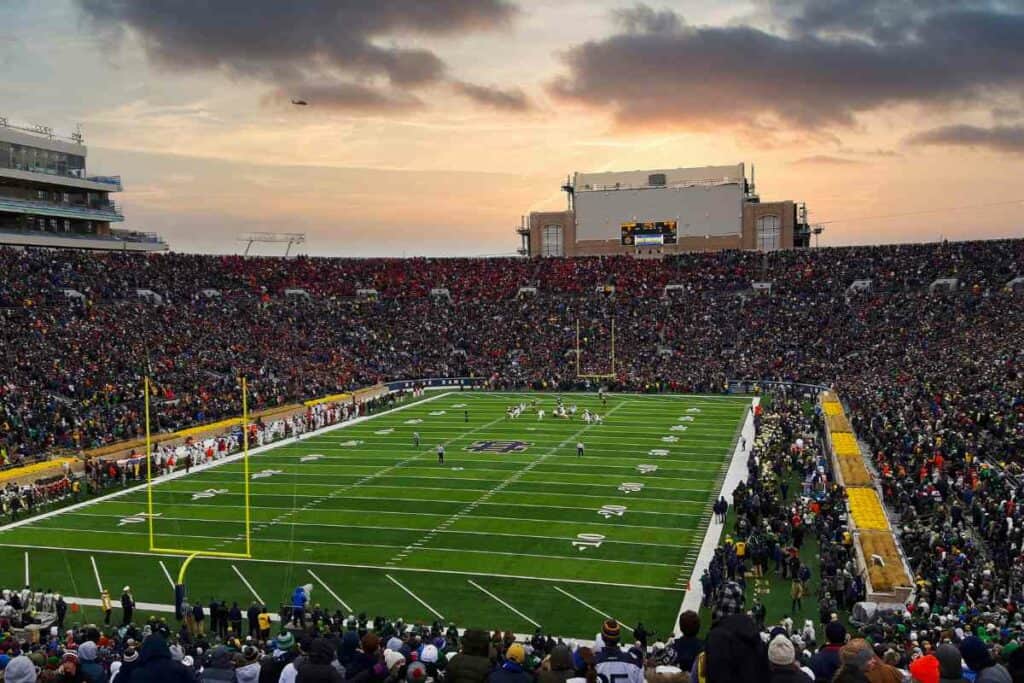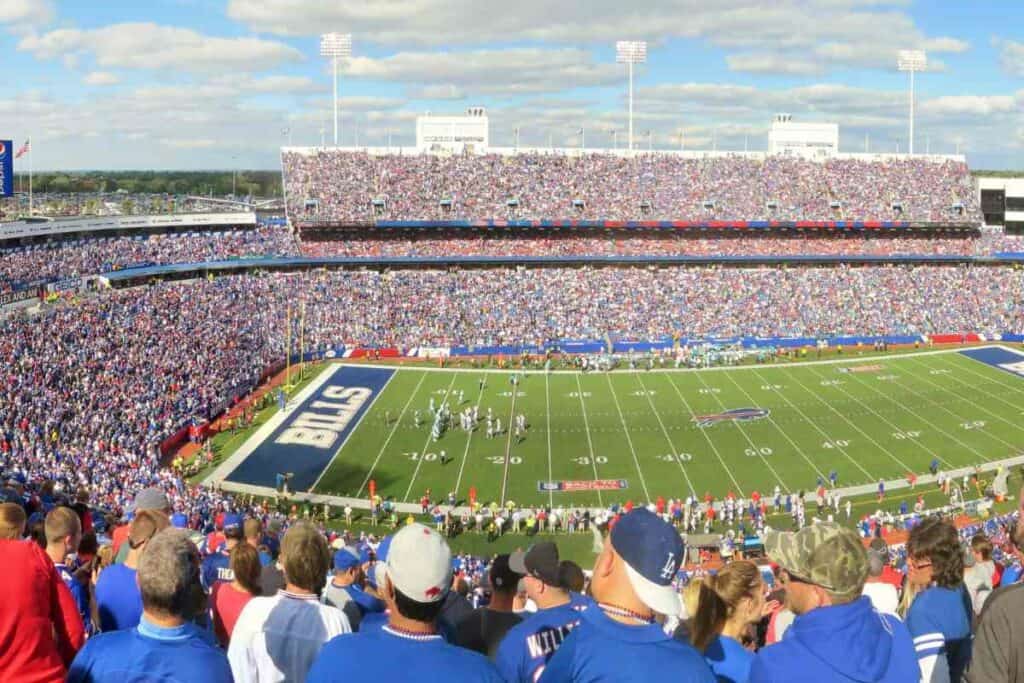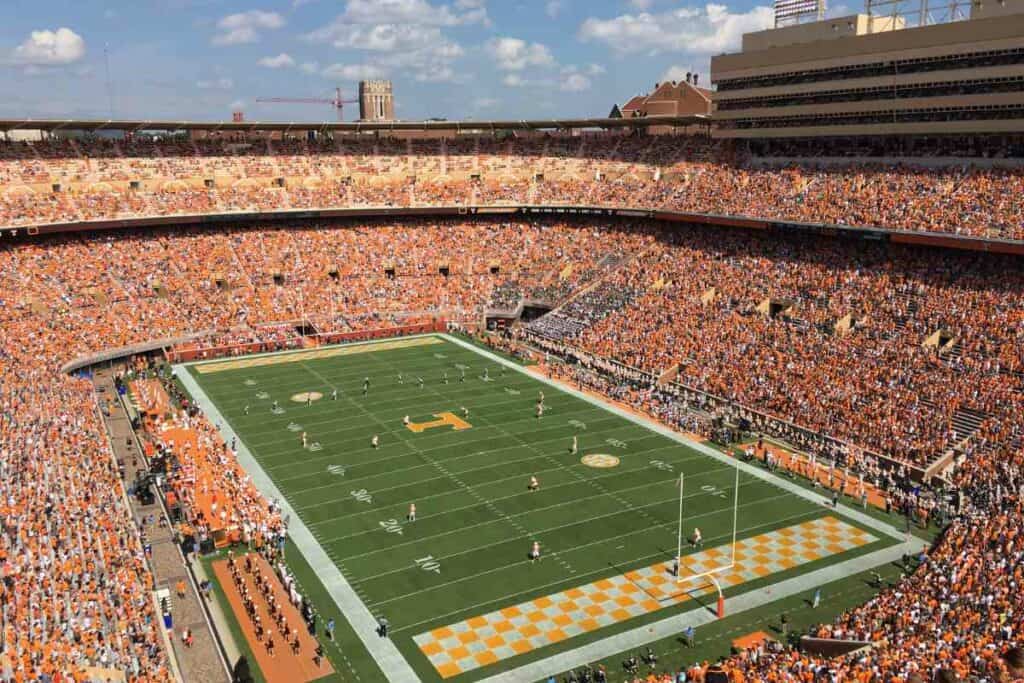What is the Average Size of a College Football Stadium?
College football stands as a cornerstone of American culture, with the stadiums hosting the games being nearly as iconic as the matchups themselves. These venues, varying greatly in size, not only showcase the immense popularity of college football but also reflect the significant investments universities make in their sports programs.

Related Post! Are College Football Fields Bigger Than High School Football Fields?
What’s The Average Size Of A College Football Stadium?
The average college football stadium in the Football Bowl Subdivision (FBS) typically seats between 45,000 and 50,000 fans. However, sizes vary significantly across different divisions and conferences, with some iconic stadiums accommodating over 100,000 spectators, reflecting the vast popularity and cultural significance of college football in the United States.
The capacity of a stadium deeply influences the game-day experience, from the thunderous cheers to enduring traditions, enhancing a team’s home-field advantage. Certain conferences boast particularly large stadiums, becoming symbols of pride and historical landmarks in their respective locales.
Key Takeaways:
- The average college football stadium accommodates a large number of fans, mirroring the sport’s widespread appeal.
- A stadium’s size is crucial to the ambiance of game day and reflects a university’s dedication to its athletic department.
- Stadium capacities differ, often influenced by the conference, with some known for their exceptionally vast arenas.
Examining Stadium Size Dynamics:
An exploration into college football stadiums reveals a transition from humble origins to today’s colossal arenas.

Historical Evolution:
From small venues hosting a few thousand to monumental stadiums holding tens of thousands, the growth of stadium sizes has paralleled the surge in college football’s popularity. Early 20th-century stadiums have evolved from 20,000-seat facilities to massive complexes through repeated expansions to accommodate growing fan bases.
Modern Developments:
Contemporary trends in college football stadiums lean towards larger and more sophisticated constructions. The standard capacity for an FBS stadium hovers between 45,000 and 50,000, yet there are stadiums breaking the 100,000-seat mark, showcasing the sport’s grandeur.
- Total FBS Stadiums: 134
- Average Stadium Capacity: Approximately 45,000-50,000
- Stadiums Seating Over 100,000: 10
Universities like Texas A&M have expanded their stadiums to over 106,000 seats, signaling a trend where stadium size is a testament to a school’s football legacy and institutional prestige.
Related Post! Are High School Football Fields Smaller Than The NFL?
Stadium Capacity Factors
College football stadiums are shaped by various factors, from architectural designs and potential expansions to the geographical context of their locations.

Design and Structure:
Each stadium has a unique design, with some featuring steep stands for higher capacity in a compact area, and others opting for a more spread-out, shallow bowl for spectator comfort. Michigan Stadium is a prime example, designed to hold immense crowds, maintaining its status among the largest venues in college football.
Expansion and Renovation:
Stadiums evolve over time, undergoing expansions and renovations to meet increasing demands:
- Initial Construction: Often planned with future expansion in mind.
- Incremental Expansion: Seating is gradually added to accommodate more fans.
- Major Renovation: Significant overhauls can drastically increase a stadium’s capacity, as seen with Texas A&M’s expansion.
Location and Geography:
The setting of a stadium can greatly influence its size and expansion capabilities:
- Urban Setting: Space constraints may limit expansion.
- Rural/University Setting: Typically offers more room for growth, allowing for larger capacities.
Comparison by Conference:

Stadium sizes also vary across different collegiate conferences, reflecting each’s unique character and traditions:
- Power Five Conferences: Known for larger stadiums, like the SEC’s Neyland Stadium and the Big Ten’s Michigan Stadium, which accommodate vast numbers of fans, symbolizing the high competition level and fan engagement.
- Group of Five Conferences: While generally smaller, stadiums like the AAC’s Navy-Marine Corps Memorial Stadium still gather significant crowds, showcasing the spirit and competitiveness unique to these schools.
- FCS Conferences: These stadiums, such as those in the Big Sky and CAA, may be smaller but are rich in passion and community, providing an intimate and thrilling football experience.
The size and capacity of college football stadiums not only reflect the sport’s popularity and a university’s commitment to athletics but also contribute to the distinct game-day atmosphere and home-field advantage experienced by teams and fans alike.
Related Post! What Size Is A High School Football Field?
Largest College Football Stadiums
The grandeur of college football is epitomized by its stadiums, monumental structures that not only host the games but also create unforgettable game-day atmospheres. Let’s explore some of the most iconic college football stadiums:
Top 5 Iconic Stadiums:
- Michigan Stadium: Known as “The Big House,” this architectural wonder in Ann Arbor boasts a staggering capacity of approximately 107,601, making it the largest college football stadium in the United States.
- Beaver Stadium: The home of the Penn State Nittany Lions, with a nearly 106,572 fan capacity, is a close contender for the top spot.
- Ohio Stadium: “The Horseshoe,” where Ohio State cheers on, holds up to 102,780 fans, securing its place among the largest.
- Kyle Field: Texas A&M’s pride, this stadium can host up to 102,733 spectators.
- Tiger Stadium: LSU’s home base is renowned for its electrifying game-day atmosphere, with a capacity of 102,321.
Historic Attendance Records:
These stadiums have also set awe-inspiring attendance records:
- The Big House: Broke records with 115,109 attendees during a 2013 Notre Dame game.
- Beaver Stadium: Saw 110,889 fans in a 2002 game against Nebraska.
- Ohio Stadium: Hosted 110,045 fans in a 2016 rivalry game against Michigan.

Impact of Stadium Size:
The size of a college football stadium can significantly influence various aspects:
- Game Day Experience: Larger stadiums provide a unique, electrifying atmosphere, fostering unity and excitement among fans.
- Financial Implications: Bigger stadiums mean more ticket sales, concessions, and merchandise revenue, enhancing the financial prosperity of college programs.
- Community and Culture: These venues serve as cultural and community hubs, building alumni connections and supporting local economies, especially on game days.
In essence, college football stadiums are not just venues for sporting events; they are integral to the game’s culture, contributing significantly to the college football experience, the financial health of athletic programs, and the vibrancy of local communities.
Related Post! How Much Does It Cost To Attend A College Football Game?
